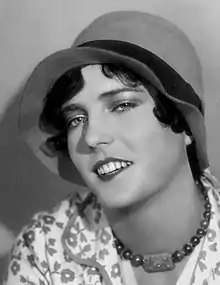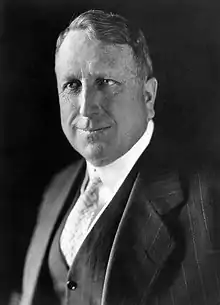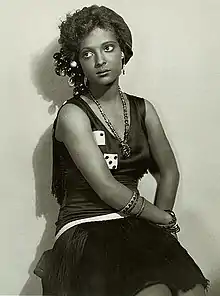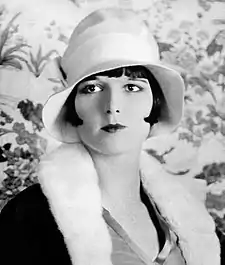Pepi Lederer | |
|---|---|
 Lederer in 1930 | |
| Born | Josephine Rose Lederer[1] March 18, 1910[1] Chicago, Illinois, U.S. |
| Died | June 11, 1935 (aged 25) Los Angeles, California, U.S. |
| Alma mater | Westlake School for Girls[2] |
| Parents |
|
| Relatives |
|
Pepi Lederer (born Josephine Rose Lederer; March 18, 1910 – June 11, 1935) was an American actress and writer.[1] She was the niece of actress and philanthropist Marion Davies.[1] A high-spirited young woman,[3] Lederer was a lesbian who had relationships with actress Nina Mae McKinney.[4] She became a well-known figure in the gay and bisexual community of Jazz Age Hollywood.
Due to either her sexual orientation or a drug addiction,[5][6] Lederer was involuntarily committed to a psychiatric ward at the behest of Davies' partner, newspaper tycoon William Randolph Hearst.[7]
On June 11, 1935, the 25-year-old Lederer took her own life by jumping from the sixth floor window of her hospital room at Good Samaritan Hospital.[8][9] A later obituary printed by Hearst's flagship newspaper, The San Francisco Examiner, depicted Lederer's suicide as an accidental mishap, and her involuntary hospitalization was attributed to "a nervous breakdown caused by overstudy".[10] Lederer is buried at Hollywood Forever Cemetery in Los Angeles.[11]
Family and early years
Born Josephine Rose Lederer in Chicago in 1910,[1] Lederer was the daughter of stage actress Reine Davies (née Douras)—the sister of Rosemary and Marion Davies—and her first husband George W. Lederer, a Broadway theatrical producer and director.[12] Lederer had a younger brother, Charles Lederer (known as "Charlie").[13] Charlie became a well-known Hollywood screenwriter who co-wrote The Front Page (1931), His Girl Friday (1940), and Gentlemen Prefer Blondes (1953).[1]
In early childhood, Lederer was nicknamed "Peppy" due to her high spirited personality. At the age of 18, she changed the spelling to "Pepi" and legally changed it to her first name.[3]
Due to her mother's alcoholism, Lederer and her brother were raised by their aunt, Marion Davies.[14] The children lived in Davies' luxurious Beverly Hills estate.[14] Lederer's mother, Reine, would occasionally appear uninvited and accuse Davies of having "robbed her of her children."[15]
When Davies became the mistress of publishing tycoon William Randolph Hearst, Lederer and her brother moved with Davies to the Hearst Castle where she spent much of her early youth during the 1920s.[16] Also at this time, Lederer attended the Westlake School for Girls in Los Angeles, California where she graduated in 1926.[2]
Life at Hearst Castle
As Lederer was "the only fixed reality in an endless procession of celebrities" at Hearst Castle, she often defied the rules set by Hearst and Davies regarding proper decorum and usually escaped unpunished.[17] She often played pranks on Hearst's important guests such as stealing actress Claire Windsor's "false bosom" and writer Elinor Glyn's red wig while they slept.[17] She delighted in inventing outlandish stories about fictitious events at Hearst Castle, and she planted these stories in Louella Parsons' syndicated gossip column much to Hearst's annoyance.[17]
Although Hearst and Davies took the ambitions of her brother Charles seriously and encouraged him to pursue a career as a screenwriter, they regarded Lederer's ambitions to be an actress far less seriously.[18][19] Nevertheless, Davies secured a part for her niece in her 1927 film The Fair Co-Ed.[20] Lederer was devastated when her part was cut from the film.[20] Her reaction surprised Davies who assumed Lederer's acting ambitions were fleeting.[20] Davies promised her niece a role in an upcoming film, but her acting career would consist only of a few small parts in Davies' films.[20]
In December 1929, Lederer upset Davies and Hearst after a mutual acquaintance told them she was involved in a sexual relationship with African-American actress Nina Mae McKinney.[4] During Pepi's affair with Nina Mae McKinney at Davies' Beverly Hills estate on Lexington Road, neighbors became irate at seeing black people on the adjacent premises and telephoned Davies.[4] Davies' sister Ethel visited the premises and found Lederer in bed with McKinney.[4] Outraged, Davies and Hearst shipped Lederer to New York City where she lived alone in an apartment at 42 West Fifty-fourth Street and continued having romantic relationships with women.[4] During this period of exile, Lederer became close friends with actress Alma Rubens, and both women allegedly shared an addiction to drugs including heroin and morphine.[21][22] Rubens died a year later in January 1931.[20]
Following a riotous New Year's Eve party in 1930, a male acquaintance drove an inebriated Lederer to her New York apartment and then raped her while she was unconscious.[23] At the end of March 1930, while still in New York, Lederer discovered she had become pregnant by her rapist.[23] As Lederer was an overt lesbian exclusively attracted to women, the news of her pregnancy shocked her friends and family.[23] Advised by her aunt Marion,[24] Lederer procured a black-market abortion.[25] The abortion resulted in severe complications which caused her lingering health problems.[26]
Life abroad and return

After recovering from the abortion, Lederer traveled with her aunt and William Randolph Hearst to Europe in 1930.[27] While staying in England, Lederer convinced Hearst to hire her to work as a writer for one of his magazines, The Connoisseur.[27] Lederer enjoyed the job and would remain in London for the next five years. She was given a generous allowance from Davies and Hearst.[27] Lederer later told her friend, Louise Brooks, that she was happy living in London and felt that she was her own person for the first time in her life.[28]
In April 1935, Lederer returned to the United States with her new girlfriend, Monica Morris, whom she met in London.[29] The couple first arrived in New York City where they stayed at William Randolph Hearst’s suite at the Ritz Tower.[29]
After several weeks, Lederer and Morris departed for Los Angeles where they stayed at Marion Davies' Beverly Hills mansion on Lexington Road. Davies and Hearst remained at San Simeon but, in an unusual move, they did not contact Lederer or invite her to any parties at Hearst Castle.[30] At this point, Lederer had become persona non grata at San Simeon due to both her ingravescent drug addiction and overt lesbian relationships with many women.[30]
Commitment and death
As a result of either her worsening drug addiction or her unconcealed sexual orientation,[5][6] Hearst had Lederer involuntarily committed to the psychiatric ward of Good Samaritan Hospital at 1212 Shatto Street in late May 1935.[31] On June 11, 1935, Lederer took her own life by distracting her nurse with a request for food and then jumping from the sixth floor window of her hospital room.[8][9][32] According to her nurse Marion Pope, Lederer had been sitting in her hospital bed reading a motion picture magazine and asked for something to eat.[33] "I turned just in time," Pope recalled, "to see Miss Lederer plunge against the window screen.... and she fell out."[8][34]
Lederer plummeted six stories to the shrubbery below the window, and she broke her neck upon striking the ground.[35] Hospital attendants rushed to the shrubbery, but she died within several minutes.[35] She was 25 years old.[33] In early newspaper obituaries, Lederer's suicide was ascribed to "acute melancholia" by her doctor, Samuel Hirshfeld.[35] Hirshfeld was a frequent visitor at San Simeon and a personal acquaintance of Hearst.[36] However, in a later obituary printed by Hearst's flagship newspaper The San Francisco Examiner, Lederer's suicide was instead depicted as an accidental mishap, and her involuntarily hospitalization was attributed to "a nervous breakdown caused by overstudy".[10]
Funeral
Two days after her suicide, a funeral service was held in the Church of St. Mary of the Angels on June 13, 1935.[2] The Reverend Neal Dodd—who only a few weeks prior conducted funeral rites in the same church for Judge Bernard J. Douras, Pepi's grandfather—officiated the service.[37] Lederer's body was then interred in the family mausoleum at Hollywood Forever Cemetery in Los Angeles.[38] Her pallbearers included Harpo Marx, Buster Collier, Orry Kelly, Ted Draper, Harry Crocker, Matt Moore, William Haines, and Jimmie Shields—William Haines' longtime gay partner.[13] With the exception of Harpo Marx, nearly every pallbearer at Pepi Lederer's 1935 funeral was a prominent gay or bisexual figure in Jazz Age Hollywood.[13]
Filmography
| Year | Title | Role | Notes |
|---|---|---|---|
1928 |
The Cardboard Lover | Flapper | Only film role |
References
Citations
- 1 2 3 4 5 6 Brooks 1982, p. 39.
- 1 2 3 San Francisco Examiner 1935, p. 7.
- 1 2 Brooks 1982, p. 39: "When she was a little girl, she was nicknamed Peppy because of her high spirits."
- 1 2 3 4 5 Brooks 1982, p. 47.
- 1 2 Brooks 1982, pp. 53–54: Brooks wrote that she inadvertently told Avis Golden—an acquaintance of Marion Davies—about Pepi Lederer's sexual orientation during a telephone call shortly before Lederer was involuntarily committed to a psychiatric ward. Lederer was shocked by Brooks' breach of confidence and stated, "Everything you told Avis she will tell Marie Glendinning, who lives next door to her in Greenwich Village, and Marie will tell Marion." Soon after, Lederer was institutionalized at Good Samaritan Hospital.
- 1 2 Brooks 1982, p. 55: Monica Morris, Lederer's lesbian partner shortly before her death, told Brooks that "without warning, Marion and Mr. Hearst decided to have Pepi committed to the hospital for a drug cure."
- ↑ Brooks 1982, p. 53-55.
- 1 2 3 Kenosha News 1935, p. 1.
- 1 2 Brooks 1982, p. 55: "In the hospital, she was left alone by the nurse for a moment in a room with steel-mesh screening over the window. In an agony of desolation, this powerful one-hundred-eighty-pound woman must have taken a running dive at the window in order to tear through the screen, and she hit the ground with force enough (according to the autopsy) to fracture her spine and almost every other bone in her body."
- 1 2 San Francisco Examiner 1935, p. 7: "Miss Lederer, who had entered the hospital on Monday to recover from a nervous breakdown caused by overstudy, fell from the window when, weak from illness, she attempted to walk alone... A brilliant student, she had continued her studies since graduating from the Westlake School for Girls in 1926, and her recently completed an intensive period of education abroad.... This overstudy led to the collapse which caused her to enter the hospital Monday."
- ↑ Brooks 1982, p. 54.
- ↑ Brooks 1982, p. 39; Kenosha News 1935, p. 1.
- 1 2 3 Driscoll 1935, p. 10.
- 1 2 Brooks 1982, pp. 39–40.
- ↑ Brooks 1982, p. 40: "Pepi said that her mother had called Marion a scheming bitch for having robbed her of her children."
- ↑ Brooks 1982, pp. 40–41.
- 1 2 3 Brooks 1982, p. 41.
- ↑ Brooks 1982, p. 34: "In contrast to their serious treatment of her brother Charlie Lederer, for whom they obtained a screenwriting job at the Metro-Goldwyn-Mayer studio, their treatment of Pepi was that accorded a naughty, entertaining child, incapable of any serious endeavor."
- ↑ Brooks 1982, pp. 47–48: "Secretly, she had yearned to be a movie actress.... Pepi realized that no one had been really serious about her career—it was just a gag."
- 1 2 3 4 5 Brooks 1982, p. 48.
- ↑ Brooks 1982, p. 48: "When Pepi hung up, she cried, 'Quick, Watson, the needle!' and dashed off to the apartment of the actress Alma Rubens, in the same building."
- ↑ Brooks 1982, p. 48: "Pepi was much sobered when, after an hour, she returned from Alma's apartment. She had to wait till one of Marion's doctors came to give Alma an injection of morphine. Pepi had found her pacing up and down like a madwoman. All her money had gone to the drug-sellers".
- 1 2 3 Brooks 1982, p. 51.
- ↑ Brooks 1982, p. 51: "Marion told her to stop wasting time.... [and] to make an appointment to see an abortionist at once."
- ↑ Brooks 1982, p. 51: The doctor "found that Pepi was pregnant, and aborted the fetus the next day."
- ↑ Brooks 1982, p. 51: "At the end of March, I stopped by the Warwick to see Pepi and found her in bed, sick, feverish, and frightened. She had had an abortion and was hemorrhaging badly."
- 1 2 3 Brooks 1982, p. 34.
- ↑ Brooks 1982, pp. 34–35.
- 1 2 Brooks 1982, p. 53.
- 1 2 Brooks 1982, pp. 53–54.
- ↑ Brooks 1982, pp. 53–55.
- ↑ Brooks 1982, p. 54: "Pepi had just killed herself by jumping out a window of the psychiatric section of the Good Samaritan Hospital in Los Angeles."
- 1 2 Akron Beacon Journal 1935, p. 1.
- ↑ San Francisco Examiner 1935, p. 7: In later obituaries published by Hearst's newspaper chain, Marion Pope's statement was later altered to imply Lederer's death was an accident as opposed to a suicide: "Suddenly I heard a noise behind me and turned in time to see Miss Lederer falling from the window, the weight of her body having pried the screen from its fastenings."
- 1 2 3 Los Angeles Times 1935, p. 1; Kenosha News 1935, p. 1.
- ↑ Vestuto 2018, p. 144.
- ↑ San Francisco Examiner 1935, p. 7; Driscoll 1935, p. 10.
- ↑ Brooks 1982, p. 54; Driscoll 1935, p. 10.
Works cited
- Associated Press (June 12, 1935). "Davies Niece in Plunge to Death: Miss Pepi Lederer Hurls Self Out Six-Story Window to Death". Kenosha News (Wednesday ed.). Kenosha, Wisconsin. p. 1. Retrieved May 1, 2022 – via Newspapers.com.
- Associated Press (June 12, 1935). "Niece of Actress Plunges to Death". The Akron Beacon Journal (Wednesday ed.). Akron, Ohio. p. 1. Retrieved May 1, 2022 – via Newspapers.com.
- Brooks, Louise (1982). Lulu in Hollywood. New York City: Knopf. ISBN 978-0-394-52071-1 – via Internet Archive.
- Brooks, Louise (2000). Lulu in Hollywood: Expanded Edition. Minneapolis, Minnesota: University of Minnesota Press. ISBN 978-0-816-63731-7 – via Google Books.
- Driscoll, Marjorie (June 14, 1935). "Pepi Lederer Goes to Rest Amid Flowers: Friends and Relatives of Talented Girl Say Last Good-by at Beautiful Burial Services". The San Francisco Examiner (Friday ed.). San Francisco, California. p. 10. Retrieved May 1, 2022 – via Newspapers.com.
- "Pepi Lederer Funeral Will Be Held Today". The San Francisco Examiner (Thursday ed.). San Francisco, California. June 13, 1935. p. 7. Retrieved May 1, 2022 – via Newspapers.com.
- "Sixth Floor Fall Fatal". The Los Angeles Times (Wednesday ed.). Los Angeles, California. June 12, 1935. p. 1. Retrieved May 1, 2022 – via Newspapers.com.
- Vestuto, Kathleen (July 26, 2018). The Lives of Justine Johnstone: Follies Star, Research Scientist, Social Activist. Jefferson, North Carolina: McFarland & Company. ISBN 978-1-4766-3131-8. Retrieved May 1, 2022 – via Google Books.

